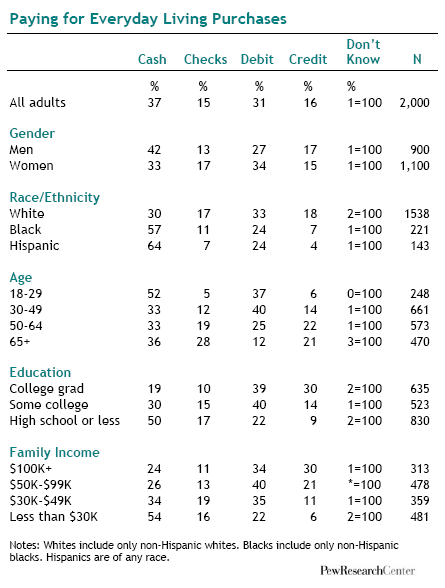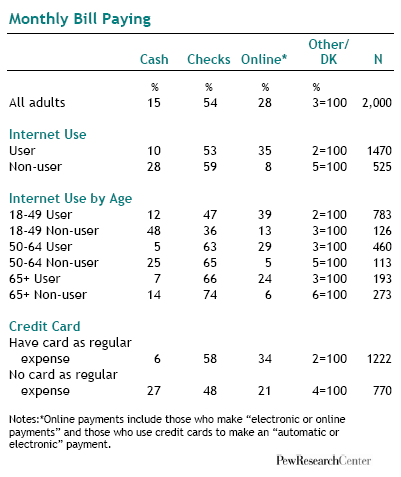VI. Cash, Check, Debit or Credit?
 Consumers have more choice than ever before when it comes to how to make a transaction for goods and services – the old standbys of cash and checks are now side-by-side with debit and credit card options for many goods and services. While some have speculated that we are moving towards a cashless – or at least a checkless – society, that verdict seems premature. When it comes to both everyday living purchases and monthly bill-paying, the Pew survey finds that both the old and new payment modes have their following.
Consumers have more choice than ever before when it comes to how to make a transaction for goods and services – the old standbys of cash and checks are now side-by-side with debit and credit card options for many goods and services. While some have speculated that we are moving towards a cashless – or at least a checkless – society, that verdict seems premature. When it comes to both everyday living purchases and monthly bill-paying, the Pew survey finds that both the old and new payment modes have their following.
For everyday purchases, about four-in-ten (37%) report they rely on cash, while 31% rely on debit cards and about half as many use either checks (15%) or credit cards (16%).
Those with lower incomes rely mostly on cash for everyday living expenses; 54% of those with incomes under $30,000 do so compared with 24% among those with incomes of at least $100,000 annually.
 For monthly bill-paying, more than half (54%) of adults say that they mostly use checks, while 28% say they mostly make electronic or online payments and 15% say they mostly use cash.
For monthly bill-paying, more than half (54%) of adults say that they mostly use checks, while 28% say they mostly make electronic or online payments and 15% say they mostly use cash.
A majority of every age group save one – adults under age 30 – relies on checks for most of their bill-paying. Among adults ages 65 and older 71% mostly use checks to pay their bills; this figure drops to 63% among those ages 50 to 64 and 51% among those ages 30 to 49. Among adults under age 30 about a third (35%) use checks for most of their bill-paying while three-in-ten use cash and 32% pay bills electronically.
Among Internet users, a 53% majority reports paying most bills by check while 35% pay electronically and 10% pay in cash.


